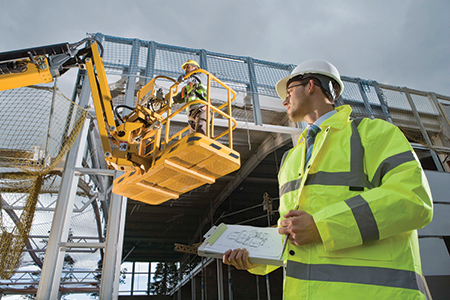If you are a residential contractor, you likely spend considerable downtime contemplating ways to increase company revenues. But, aside from improving efficiency, greater revenues are often realized only by way of greater sales, and additional work can prove hard to come by in an already competitive local market. So where does one go for new opportunities? Well, instead of laboring to wring every last drop out of your current residential market, maybe it’s time to expand the market itself. Maybe it’s time to look into commercial construction.
New Horizons?
But I know what you’re feeling—apprehension, uneasiness, and that’s understandable. To those not yet indoctrinated, commercial construction (CC) can appear daunting. Suddenly there are architects, engineers, liquidated damages, bonding, and a cast of wealthy business clients with short attention spans and scary-sounding law firms on speed-dial. There are new regulations, strict protocols, and new competition. “I wouldn’t know where to begin,” you tell yourself.
Well, I was in your shoes. I was in residential construction ten years before getting into commercial work (which is 25 years and counting now), and I can attest that the transformation from residential to commercial construction was (in no particular order) exciting, terrifying, exhilarating, frustrating and rewarding. There were unknowns, hurdles and, admittedly, leaps of faith. There was a risk. But most of us have learned that without this pesky little thing known as risk, there’s often little chance for any worthwhile reward.
But risk doesn’t necessarily mean blind risk. Anyone can hedge his or her bet through knowledge. With enough quality information and preparation, that person can turn a risky decision into an informed choice. So let’s start the process and see if we can make our transition to commercial construction a little less intimidating by breaking the process down into less-threatening, more-acceptable doses. And there’s no better place to start than the beginning:
Finding Commercial Construction Work: Reporting Services
As a residential contractor, new work likely came via local advertising, your website, personal referrals, and industry contacts (i.e., real estate brokers, material suppliers). These are still great strategies for acquiring work in CC, but there are other avenues for an opportunity in place for you. One of these is known collectively as reporting services. You may already be familiar with these reports, sometimes colloquially referred to as Dodge Reports, published by F.W. Dodge® [www.fwdodge.com], one of the leaders in construction reporting. A host of firms offer similar services such as BidClerk® www.bidclerk.com; Construction Market Data® (formerly Reed Construction Data) www.cmdgroup.com; or Government Bids® www.governmentbids.com. While services vary, most of these places publish information about:
- Competitive-bid CC projects in your area.
- CC projects in the planning or negotiated stages.
- CC projects that have recently been awarded (and more).
These services are for construction managers (CMs), general contractors (GCs), subcontractors, suppliers and anyone with a vested interest in commercial construction work. Most of these reports include pertinent details regarding the project such as a description of the work itself, the architect/engineer (A/E), the owner and even bidding companies currently holding plans. They’ll also give a bid date/time and may even tell you how to go about acquiring bidding documents (many sites even offer downloadable electronic versions).
Depending on your area of expertise, you can find information on construction opportunities ranging from nuclear work to waterpark construction. If there’s a niche, there’s probably a reporting service for it. But just a heads-up: most of these services are available only via paid subscriptions (or other fees), so you may need to do a little homework and even shell out a little cash while determining which site is best for you.
Construction Organizations & Plan Rooms
Another popular avenue for exploring CC opportunities is through your local construction organization such as the AGC (Associated General Contractors) and ABC (Associated Builders & Contractors) and a host of other groups that represent a wide and varied array of sub-contractors, suppliers, support agencies and government bodies who work in the CC industry. You may already belong to one of these associations. These groups also often sponsor local and/or area plan rooms (both physical and online) where blueprints and specifications on upcoming/bidding CC projects can be viewed or (in some cases) checked out or downloaded for you to perform takeoffs and estimates. Again, some ask for a fee and others don’t.
Designer Direct
Depending on the project delivery method, you may be able to acquire bid packages (plans and specifications) directly from the project architect or engineer (A/E). This acquisition will often require a fee/deposit, and you may find, if you’re a second-tier subcontractor or supplier, that these firms are selective over who/how they distribute bidding documents. Many firms cater only to prime contractors such as GCs or CMs. But if the firm is willing, you may have to go through a pre-screening process involving references, financials, and experience before being put on their select contractors list, but it’s worth the time and effort. Being on these short-lists allows you greater access to the designers, and even the owners/clients, that potentially provide an advantage when it comes time for bidding a project.
Architects & Engineers (A/E)
Your residential involvements, thus far, with architects and engineering firms has likely been infrequent—maybe even none at all. This situation changes once you enter commercial construction. There are some reasons for this. First, commercial construction work is, with exceptions, much larger, more intricate, and more costly than residential undertakings. With so much at stake, it’s not surprising that the CC client doling out so much cash wants to feel comfortable knowing their project is in the hands of highly trained, appropriately licensed and formally credentialed individuals or organizations.
Another more practical reason you will see more A/Es in commercial construction is simply because most metropolitan jurisdictions (especially in the US) require commercial plans and specifications to be stamped with a licensed architect’s or engineer’s seal/signature on the documents themselves before building permits will be issued. This requirement is not the case with residential work unless the homes are exceedingly large or complex.
The Clients
One of the most edifying and enlightening things I came across in my transition to CC had less to do with the process itself and more to do with the nature of the CC client. I loved them. Again I’m generalizing, but I found that commercial clients, as a group, were far easier to work with than my residential customers had been. I believe much of it had to do with the fact that my new CC clients were, for the most part, seasoned professionals. They were business people, who understood that things happen in business and that one must calmly face day-to-day hurdles until they are overcome.
This was starkly different from breaking the painful news to Tom and Tina Freshface (the 25-year-old, starry-eyed newlyweds) that the sprawling, exquisite dream home they’d pictured in their minds was far in excess of what their dreams could actually afford (cue crying fit – I’m talking Tom, not Tina!).
CSI (Construction Specification Institute)
When preparing a typical competitive-bid CC estimate, more often than not you will be working from working drawings (plans) and a specification manual (often separate and bound in book form) along with any relevant correspondence or addenda (changes to the bidding documents after the publication date) that pertain to the bid package. You’re already familiar with drawings but the manual, or spec book, may be new to you, and it is often (for private projects) laid out in CSI (Construction Specification Institute® 2014) numerical order.
CSI is a private organization founded in 1948 by specification writers of government agencies who came together to improve the quality of construction specifications. The Institute’s efforts were essential in improving construction specification quality so it could meet the demands of post-war construction booms. The Institute grew quickly and today includes more than 13,000 specifiers, architects, engineers, contractors, facility managers, product representatives, manufacturers, and owners who are experts within the building construction industry. You can learn more about CSI by visiting their website at http://csinet.org.
Here is a sample of how a typical CC specification manual might be broken down in CSI:
Division 00 – Procurement and Contracting Requirements
Division 01 – General Requirements
Division 02 – Existing Conditions
Division 03 – Concrete
Division 04 – Masonry
Division 05 – Metals
Division 06 – Wood, Plastics, Composites
Division 07 – Thermal & Moisture Protection
Division 08 – Openings
Division 09 – Finishes
Division 10 – Specialties
Division 11 – Equipment
Division 12 – Furnishings
Division 13 – Special Construction
Division 14 – Conveying Equipment
Division 21 – Fire Suppression
Division 22 – Plumbing
Division 23 – Heating, Ventilating, and Air Conditioning (HVAC)
Division 26 – Electrical
Division 27 – Communications
Division 28 – Electronic Safety and Security
Division 31 – Earthwork
Division 32 – Exterior Improvements
Division 33 – Utilities
There are many more divisions and sub-divisions (even sub-sub-sub divisions!) and the actual numbers/divisions used reflect the type and scope of the project. As a construction contractor GC or CM, you will need to read and understand all divisions. If you’re a specialty subcontractor or supplier, you may only be interested in those parts that affect or are related to your scope of expertise. But regardless of your specialty, everyone is responsible for reading and complying with these divisions:
00 Procurement & Contracting Requirements
01 General Requirements
These first two divisions (0 and 1) place additional responsibilities on ALL participants including special insurances, bonding requirements, allowances, warranty/closeout procedures, safety programs, OSHA requirements, and much more. These requirements all cost money, and most are referred to in the industry as indirect costs (or indirects). Think of indirects as those tasks that cost your company money but are not associated with physical hands-on construction.
As a CC contractor, you’ll learn indirect costs can mount in a hurry (I have a separate spreadsheet page in my Excel workbook feeding to my front summary page) and must be considered and the costs calculated as you would any direct cost, like masonry or concrete. Don’t expect to be reimbursed for these responsibilities (unless it was previously negotiated) after the work has been awarded. CC clients (or if you’re a sub-contractor or supplier) and GC/CMs don’t like surprise charges once the project is underway.
Bonding and Surety
Of course, there are exceptions, but on a whole, I think it’s fair to say that CC projects tend to be more expensive than residential. With more at stake, and given that construction by its very nature can be risky and volatile, it is little wonder bonding companies exist. Commercial clients are often business leaders, and commercial construction projects are major investments, so it simply is not good business to gamble on a contractor going belly-up in the middle of a project. This point is where the bonding company comes in. Bonding companies (sometimes referred to as Sureties) offer what is known as surety bonding. This additional insurance provides the client enhanced peace of mind by assuring them the hired contractor will:
- Enter into a contract for the originally quoted price of work (a bid bond) and/or
- Complete the work as promised and pay their workers, sub-contractors, and suppliers punctually and according to the language outlined in the contract. Thus thwarting any sub or supplier liens that might potentially come back to haunt the owner once the punch list is complete, and the contractor is off-site (performance and/or material payment bond).
The surety bond gives the owner a fall back in case a default should take place. The surety company allows its financial resources to be used to back up the commitment the contractor has made to the owner. If the contractor defaults, the surety steps in to finish the job and sort out the mess. Of course, the surety company doesn’t do this for free. There is a fee, a premium, for such service; and often it is included in the bonded contractor’s bid (a cost which eventually is passed onto the client). When first starting out, lesser-experienced commercial contractors may pay a higher premium for bonding. They may even be denied a bond altogether.
One of the harsh facts about commercial construction is that it can take years of gaining experience, building a positive reputation, and creating a sound financial history before a reputable surety company will take a chance on providing you a bond. But it’s worth the trials. Once bondable, your company will gain more bidding opportunities because many commercial clients simply won’t allow unbondable firms to bid their projects. Premium fees are assessed as a percentage of the contract cost of work. After you’ve been with your bonding company awhile and demonstrate a positive, proven track-record, your rates will be periodically reviewed and, if the surety is satisfied with their risk in you, even reduced.
The Submittal Process
Once awarded a contract or purchase order for a CC project, it is common for the owner’s representative (normally the GC or CM) to request a submittal package from you before they will allow your work to proceed further. The submittal process is a checks and balances system that helps to ensure clients and designers that you are indeed providing the proper, specified products and installation methods required by the bid package. With virtually all CC projects, you are required to bid the project “plan and spec.” You may suggest a substitution (which may or may not be accepted) during the bid period, but this does not relieve your responsibility to provide the product or method as it was originally specified.
Depending on your trade, the submittal process may include shop drawings, specification/detail sheets, samples, demonstrations, and even mock-ups of a particular construction assembly. The specification manual will tell you what is expected of your trade. If you are a sub-contractor or supplier, the submittal normally is presented to the GC/CM for review/approval and is then forwarded to the A/E firm for their nod. The A/E reviews the package and returns it to the GC/CM (with remarks including “approved,” “not approved–resubmit,” or “approved with notations”) who then sends it back to you for ordering/processing. Warning: this process can take time. Depending on the type of project and the A/E firm, I’ve encountered waits ranging from 1 day to 6 months! Since this process is inherently a pre-requisite to ordering material and scheduling manpower, one can easily see how crucial the submittal process is in maintaining project schedule.
Contracts and Schedule (Liquidated Damages)
While we’re on schedules, another thing you may not have encountered in residential work is scheduling penalties. As a commercial construction business, you will be expected to perform all work skillfully, completely, and on time. Contractual agreements and project schedules (as mentioned earlier) are extremely important in commercial construction. Not making pre-set milestones and completion dates can serve up substantial penalties for those contractor(s) involved. Known as liquidated damages (or LDs), this penalty normally is assessed as a fixed dollar amount paid back to the owner for every day the contractor is late delivering the project. On the flip-side, there may also be bonuses for finishing ahead of schedule, so be sure to read the specification manual and all contracts.
Success
This information is but a fraction of what you’ll likely encounter in your new CC life, but hopefully, it gives you some small insight as what to expect. Like most things in life, all the important items can be addressed and conquered as you go. Perhaps the best advice anyone could receive: be persistent, enthusiastic, and prepared to battle through some adversity. After a while, there will be far more good times than bad. If the company leadership remains steadfast, honest, and sincere in their commitment to providing quality workmanship, safety, and customer relations to their clients, they will have no problem succeeding. Good luck!















Find Us on Socials